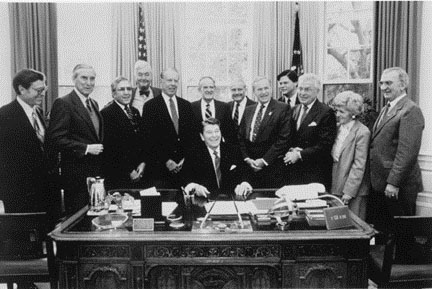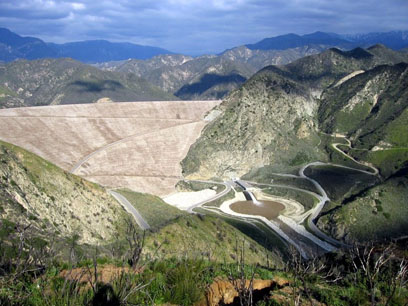The Water Resources Development Act of 1986 (WRDA-86) Fundamentally Changed the Way the Corps Planned and Financed Water Resources Projects
The Water Resources Development Act of 1986 (WRDA-86) provided congressional authorization for U.S. Army Corps of Engineer projects across the Nation and signified a major and enduring shift in the Nation’s attitude toward water resource planning. Signed on November 17, 1986, by President Ronald Reagan, the bipartisan legislation reflected a growing consensus that local stakeholders should bear more of the financial and management burdens of waterway projects and that environmental considerations were intrinsic to water resources planning.

President Ronald Reagan, surrounded by congressional sponsors
and Robert K. Dawson, Assistant Secretary of the Army (Civil Works)
(fourth from right), signing WRDA-86.
The centerpiece of this legislation was a set of cost-sharing provisions that promoted a more efficient use of tax dollars. Additional provisions included the imposition of ad valorem cargo taxes to maintain harbors, increases in fuel barge taxes to support inland lock and dam projects, and various other fiscal reforms designed to educe greater participation by ports, communities, waterway interests, and states in the financing of water projects. To balance requirements for greater non-federal financial shares in the costs of studies and projects, WRDA-86 gave sponsors a key role in project planning and design.
After 16 years without any major authorization for new civil works water resources construction projects, WRDA-86 also ushered in a torrent of new projects. It authorized $16 billion in spending for more than 377 water projects, including 43 port projects, 7 inland waterway projects, 115 flood control projects, 24 shoreline protection projects, and 61 water resources conservation and development projects. Some of the more notable of these were the Environmental Management Program (EMP) for the Upper Mississippi River system; a new large lock at Sault Sainte Marie, Michigan; significant navigation improvements along the Lower Mississippi River; and the Seven Oaks Dam in San Bernardino County, California.

Seven Oaks Dam in San Bernardino County, California,
approved for construction in WRDA-86. Photo: Steve Schumaker.
The law included reforms to make the Corps’ civil works program more environmentally friendly as well. It established requirements and guidelines for addressing mitigation measures for fish and wildlife adversely affected by water resource projects and enabled the Corps to modify the structures and operations of its projects for the purpose of improving the quality of the environment.
“WRDA-86 brought out the best in the Corps,” said Robert K. Dawson, former Assistant Secretary of the Army (Civil Works), who helped shepherd the bill from negotiation to enactment. “It was a time of great change, and the Corps as an institution showed its capacity to change and deal with reality. There were people who didn’t want to change, but the Corps to its great credit saw the need for change and went to battle stations.” WRDA-86 has lived up to its initial billing as “landmark legislation” in the development of the Nation’s water resource policy.
* * *
November 2006